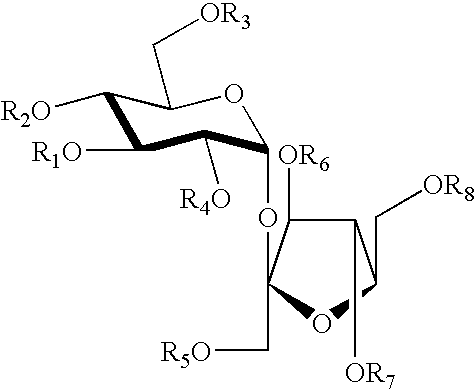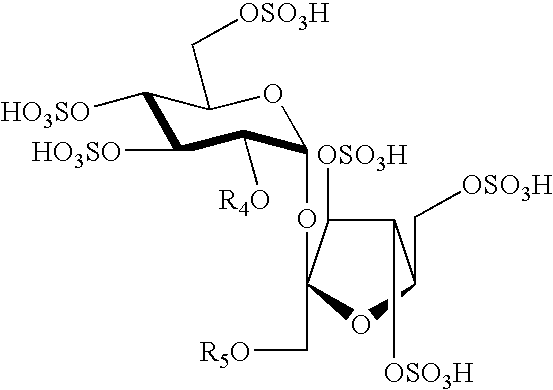Structure-based design and synthesis of FGF inhibitors and FGF modulator compounds
a technology of fgf inhibitors and modulators, which is applied in the direction of peptides, receptors for growth factors/regulators, biological material analysis, etc., can solve the problems of insufficient capability for large-scale preparation of homologous heparin oligosaccharides suitable for therapeutic applications, and the inability of fgf polypeptides to induce receptor dimerization by themselves, so as to effectively promote the dimerization of fgf-
- Summary
- Abstract
- Description
- Claims
- Application Information
AI Technical Summary
Benefits of technology
Problems solved by technology
Method used
Image
Examples
example 1
SOS Promotes Dimerization of FGF-FGFR Complexes
[0200] This example describes experiments that were performed in vitro to test whether sucrose octasulfate (SOS) can act as a heparin mimetic. Specifically, the data obtained from these experiments demonstrate that SOS is able to promote the dimerization of complexes between fibroblast growth factor receptors and their ligands (i.e., FGF-FGFR complexes).
[0201] A construct encoding an extracellular ligand binding portion of the FGFR1 polypeptide set forth in FIG. 1A (SEQ ID NO:1) was expressed in E. coli and refolded in vivo using established protocols, as previously described by Plotnikov et al. (Cell 2000, 101:413-424). In particular, the soluble FGFR1 polypeptide expressed by this construct, which is referred to here as D23, comprises amino acid residues 142 to 365 of SEQ ID NO:1, which correspond to the immunoglobulin (Ig)-like domains 2 and 3 (D2 and D3, respectively), which are known to confer ligand binding and specificity for t...
example 2
SOS Promotes Activation of the FGF Receptor by FGF in Cells
[0206] This example describes experiments that investigated the ability of SOS to modulate FGF ligand-dependent activation of the FGF receptor in vivo. In particular, an assay is described here that uses a BaF3 cell line which overexpresses FGFR1. This cell line has been previously described and is therefore known in the art (see, e.g., Huang et al., J. Biol. Chem. 1995, 270:5065-5072).
[0207] BaF3 cells are a lymphoid cell line, which are dependent on interleukin-3 (IL-3) for growth. Ordinarily, these cells do not exhibit any response to FGF. However, when stably transfected to express an FGF receptor, the cells exhibit a dose-dependent mitogenic response to FGF ligand in the absence of IL-3. Accordingly, the growth rate of such transfected cells is useful as a measurement of FGF receptor activity in vivo. Because BaF3 cells express only low amounts of HSPG, soluble heparin must also be present to elicit the FGF-dependent ...
example 3
Crystallography of an FGF-FGFR Complex with SOS
[0211] This example describes x-ray crystallography experiments that better characterize the molecular mechanisms by which SOS may interact with and / or stabilize dimers of FGF-FGFR complexes. In particular, this example describes the crystalization of FGF2-FGFR1 complexes with SOS and the solution of that crystal structure by analyzing x-ray diffraction data.
[0212] Crystals of dimeric FGF2-FGFR1-SOS complexes were grown by vapor diffusion at 20° C. using the hanging drop method. 2 μL of protein solution (10 mg / mL in 25 mM HEPES-NaOH (pH 7.5) and 150 mM NaCl) was mixed with an equal volume of crystallization buffer (12-16% Polyethylene glycol 5000, 0.2 M ammonium sulfate and 15% glycerol in 0.1 M HEPES-NaOH (pH 7.5)). The protein solution contained a 1:1:1 stoichiometric ratio of FGF2, and soluble FGFR1 construct described, supra, in Example 1, and SOS.
[0213] The resultant crystals are shown in FIG. 5A. The crystal belongs to the orth...
PUM
| Property | Measurement | Unit |
|---|---|---|
| composition | aaaaa | aaaaa |
| structure | aaaaa | aaaaa |
| crystalline structure | aaaaa | aaaaa |
Abstract
Description
Claims
Application Information
 Login to View More
Login to View More - R&D
- Intellectual Property
- Life Sciences
- Materials
- Tech Scout
- Unparalleled Data Quality
- Higher Quality Content
- 60% Fewer Hallucinations
Browse by: Latest US Patents, China's latest patents, Technical Efficacy Thesaurus, Application Domain, Technology Topic, Popular Technical Reports.
© 2025 PatSnap. All rights reserved.Legal|Privacy policy|Modern Slavery Act Transparency Statement|Sitemap|About US| Contact US: help@patsnap.com



